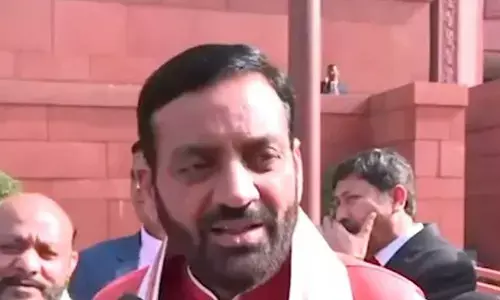James Webb Space Telescope Is Set To Launch And Will Look Into The Origins Of The Universe

The 6.5-metre-wide primary mirror of the James Webb Space Telescope is folded up for launch. Credit: NASA/Chris Gunn
- Presently, three decades later, NASA's James Webb Space Telescope (JWST) is set to launch, and Lisa Dang has already logged some of the JWST's initial observation time – in a field that didn't even exist when the telescope was constructed.
- The Webb spacecraft, which is a collaboration between NASA, the European Space Agency (ESA), and the Canadian Space Agency (CSA), is set to launch from a launch pad in Kourou, France.
Astronomers began working on the world's most ambitious and sophisticated space observatory. Presently, three decades later, NASA's James Webb Space Telescope (JWST) is set to launch, and Lisa Dang has already logged some of the JWST's initial observation time – in a field that didn't even exist when the telescope was constructed.
Lisa Dang, an astrophysicist and PhD student at McGill University in Montreal, Canada, will use the Webb telescope to look for a planet beyond our Solar System. It's known as K2-141b, and it's a world so hot that it's partly molten rock on the surface. She is one of several of astronomers who found out in March that they had received telescope observing time. The Webb spacecraft, which is a collaboration between NASA, the European Space Agency (ESA), and the Canadian Space Agency (CSA), is set to launch from a launch pad in Kourou, France.
If it all goes according to plan, Webb will revolutionise astronomy by peeking into one of the most distant galaxies ever observed, the atmospheres of far-off planets, and the dust-encrusted hearts of star-forming zones. Webb will unveil formerly hidden features of the Universe, being around 100 times stronger efficient than its predecessor, the Hubble Space Telescope, which has changed the knowledge of the cosmos over the past 31 years.
However if something goes wrong, it will be a humiliating setback for what is already the world's most costly astronomical wager. The telescope took decades to build and cost more than $10 billion, with periodic delays eating into NASA's astrophysics budget. The telescope has been the subject of debate this year over whether it should be named after James Webb, the NASA administrator in the 1960s when a NASA employee was sacked on suspicion of being gay. In the late 1940s and early 1950s, Webb worked in the US Department of State, where he had a high-ranking position at a period when the department was actively weeding out and terminating gay and lesbian employees based on their sexual orientation.
Heidi Hammel, an astronomer and vice-president for science at the Association of Universities for Research in Astronomy in Washington DC said that after so many difficulties and debates, the telescope will finally take off, carrying the hopes of thousands of astronomers all around the world. He took it as a verge of something monumental.
While explaining about the cost of it he stated that Webb's total cost was first estimated at $1 billion — a figure few believed even at the time — but has since risen dramatically. NASA committed $9.7 billion, which included financing for space operations; ESA contributed €700 million (US$810 million); and the CSA contributed Can$200 million (US$160 million). The project's ever-increasing expenses drew close scrutiny from government auditors, as well as ongoing questions about whether it was worth the astronomical price tag.
Webb is finally sitting at the Kourou spaceport, 32 years after its creation, in preparing for launch. It's on its way to a location 1.5 million kilometres from Earth, too far out for astronauts to explore and repair if something goes wrong. Hubble needed an after-launch repair in 1993, when astronauts used the space shuttle to reach the Earth-orbiting observatory and replace corrective optics for its principal mirror, which had been poorly grounded.
Webb will study the cosmos in the tended to score to mid-infrared wavelengths, most of which are lengthier than Hubble can observe, if it launches successfully. As a result, Webb will be able to investigate light that has travelled from faraway galaxies and been extended to redder wavelengths due to the Universe's expansion. Webb will also be able to examine the dust that engulfs star-forming regions, as well as the gas between the stars, which are both less observable at lower wavelengths.
Meanwhile, Dang will use Webb to observe a number of exoplanets, but the research she is leading will focus on the world K2-141b, which is only 1.5 times the size of Earth and orbits its star so close that part of it is molten. It's a remarkable 'lava planet,' with geology that's unlike anything else in the Solar System. Webb's infrared vision might detect minerals evaporated from K2-surface 141b's in its atmosphere, and the observatory could potentially track temperatures across the planet.
Itwill look for a variety of exoplanets, particularly gas giants and the most frequent form of exoplanet found so far and planets that are larger than Earth but smaller than Neptune.
Next Story

















